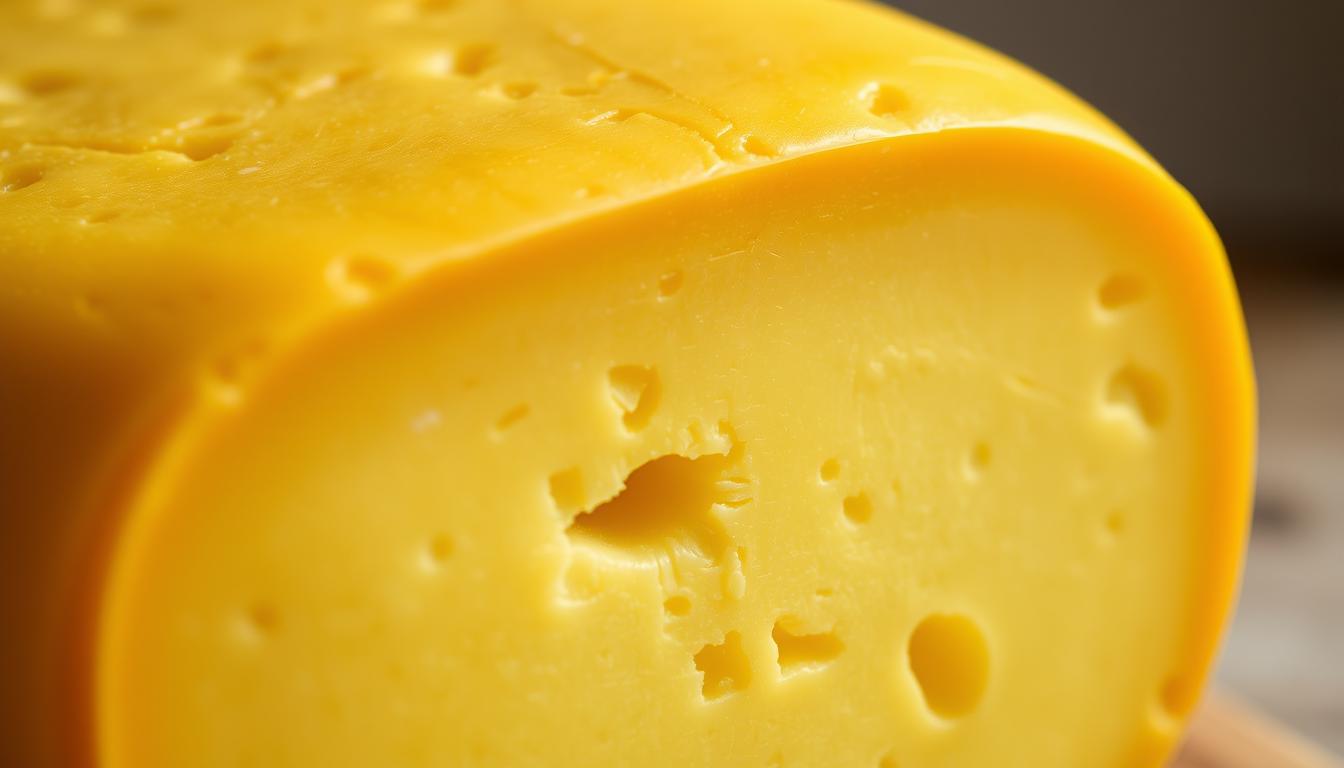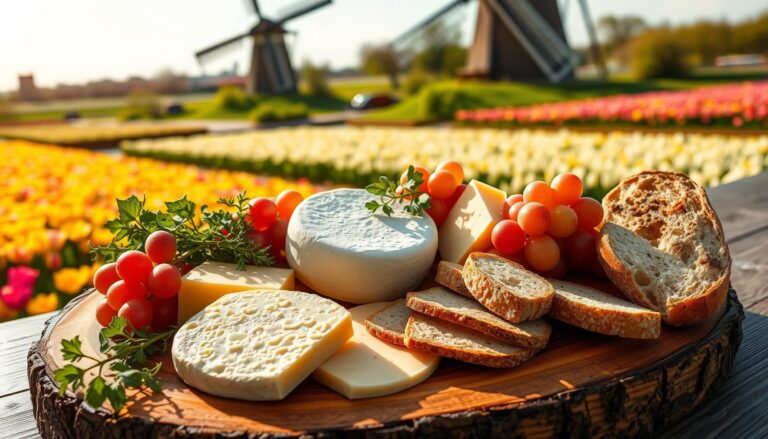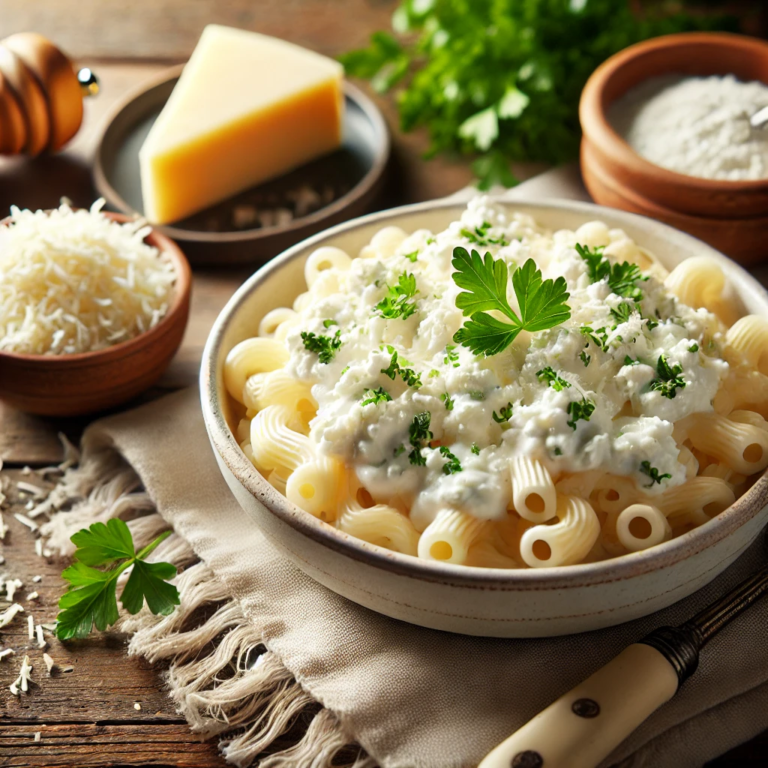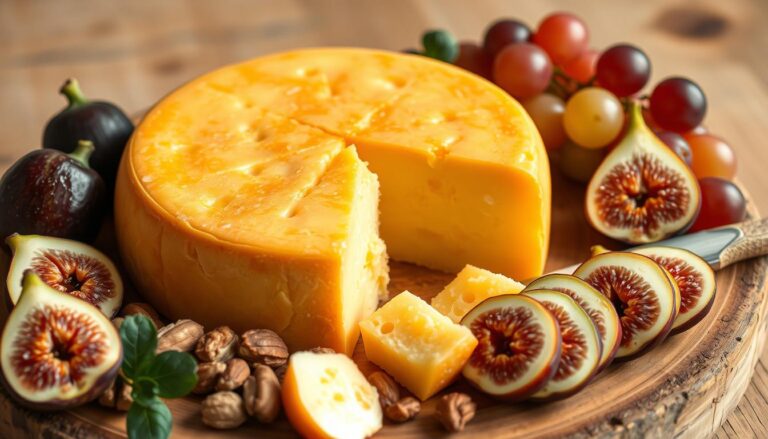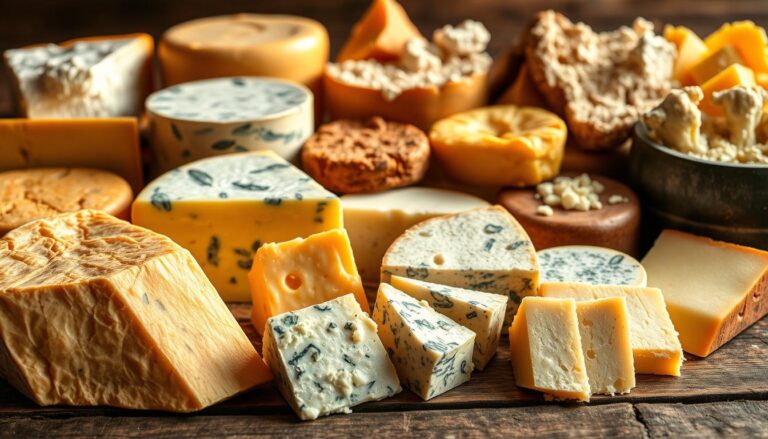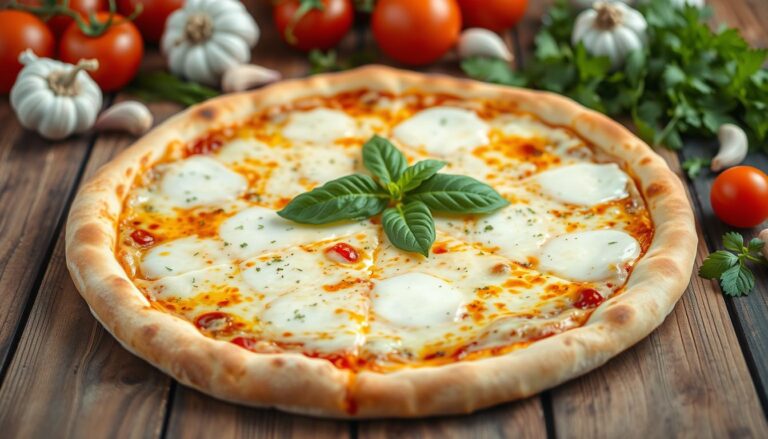Caciocavallo: A Delectable Italian Cheese to Savor
Caciocavallo is a special Italian Cheese from Southern Italy, mainly Calabria, Basilicata, and Campania1. It’s known for its unique shape and taste, which changes with age. This makes it a favorite among cheese lovers. For more on Caciocavallo, check out Italian Cheese to discover its rich history and how it’s made.
Caciocavallo has a creamy, buttery taste with a tangy hint. It’s creamier than Provolone Dolce but milder than Provolone Piccante1. Its texture can be semi-soft to semi-hard, depending on aging. This makes it great for many dishes.
Key Takeaways
- Caciocavallo is a unique Italian Cheese with a distinctive shape and flavor.
- It originates from Southern Italy, mainly Calabria, Basilicata, and Campania1.
- Caciocavallo has a creamy, buttery taste with a hint of tanginess.
- The texture of Caciocavallo can vary from semi-soft to semi-hard depending on the aging process1.
- Caciocavallo is a versatile cheese for various culinary applications, including grilling, melting, and serving with cured meats and olives.
The Rich Heritage of Caciocavallo Cheese
Caciocavallo cheese has a long Caciocavallo Heritage that goes back centuries. It comes from Southern Italy, where it’s been made for generations2. This cheese has roots dating back to the Byzantine era, over 1,500 years ago2.
The making of Caciocavallo is special. It’s aged for two months to two years2. This aging makes the cheese taste richer, loved by many. In Southern Italy, it’s a big part of festivals and family gatherings2.
Some key things about Caciocavallo cheese are:
- It’s full of calcium and protein, good for bones and muscles2
- The aging process makes it taste more complex2
- It’s aged by hanging it over a wooden beam or horse saddle2
In places like Abruzzo, they use rare Red Cow milk for Caciocavallo3. It’s aged for at least 90 days, making it firm and flavorful3. The mix of Caciocavallo Heritage, Southern Italy, and Traditional Production makes it a favorite among cheese fans.
Understanding Caciocavallo’s Unique Characteristics
Caciocavallo is a Unique Cheese from Southern Italy, with roots going back to the 14th century4. It’s made by coagulating milk at 36-38 degrees Celsius (96-100 degrees Fahrenheit)5. This cheese is known for its dense texture, buttery taste, tangy notes, and a hint of spice. It’s a key part of Italian Cuisine.
The nutritional value of Caciocavallo is impressive. It has 27 g of fat, 29 g of protein, and 829 mg of calcium per 100 g4. It’s aged for at least 30 days, with the best aged for about a year5.
For those curious about Caciocavallo, there are resources like the Caciocavallo recipe and info on
Caciocavallo’s special traits make it great for many dishes. Its rich history and cultural importance have won it fans worldwide5. With its unique taste and health benefits, it’s a fantastic choice for any Italian Cuisine dish.
The Art of Making Caciocavallo
Making Caciocavallo cheese is a mix of old ways and careful steps. It starts with heating and mixing milk with rennet, then stretching and shaping the curd6. This work needs skill and patience, as the curd must be handled softly to keep its delicate shape.
The aging process is key in making Caciocavallo. It lets the cheese get its unique taste and texture. The cheese ages for months, with regular turns and checks to age evenly7. This can make the cheese taste mild and creamy or sharp and tangy.
Some key things about making Caciocavallo include:
- Using old methods, like wooden vats and manual stretching6
- The aging process, which can change in length and conditions7
- The importance of quality standards and PDO status for some Caciocavallo types
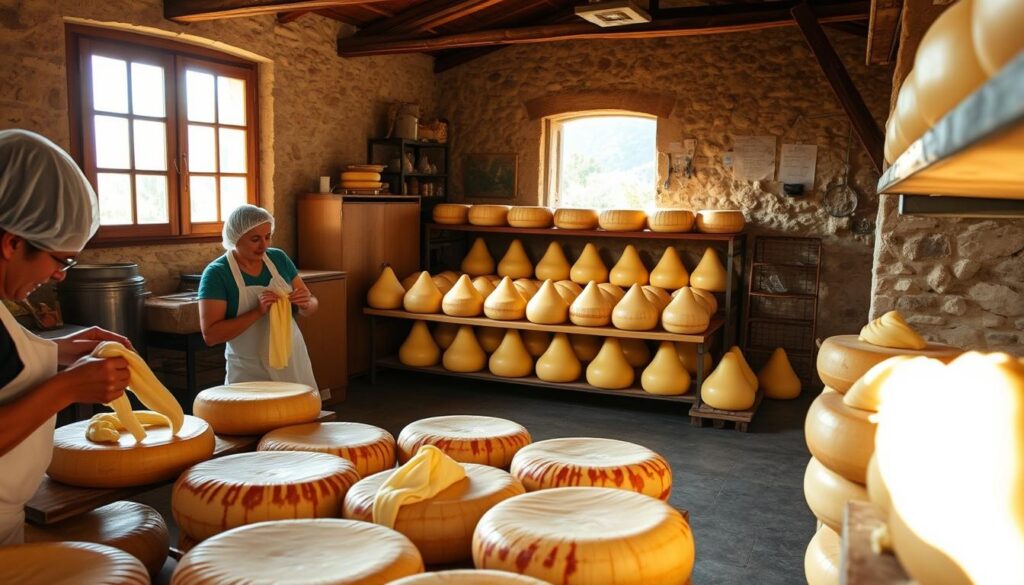
Distinctive Flavor Profile and Texture
Caciocavallo cheese has a distinctive cheese taste that changes with age. When fresh, it tastes mild and buttery. As it ages, it becomes nutty, tangy, and slightly spicy8. Its texture is firm and smooth when young, turning crumbly with age8. This mix of Caciocavallo Flavor and texture makes it a favorite in many dishes.
Compared to other cheeses, Caciocavallo is milder than Provolone Piccante but richer than Provolone Dolce. It has a creamy, buttery taste with a tangy hint9. The aging process makes its flavor stronger over time9. For more on cheese, check out Caciocavallo and other Italian cheeses.
Caciocavallo cheese is great for many Italian dishes. It has a semi-hard texture that’s smooth and creamy. Its flavor is a mix of tangy provolone and creamy mozzarella. It’s also packed with protein, calcium, and phosphorus, which are good for bones9
Varieties of Caciocavallo Across Italy
Caciocavallo cheese comes in many Regional Cheese varieties, each with its own special traits. The type of Caciocavallo depends on the region, the milk, and how it’s aged. For example, Caciocavallo di Castelfranco, Caciocavallo Silano PDO, and Caciocavallo Podolico are some of the most famous types, showing Italy’s rich cheese culture.
The Caciocavallo Varieties are not just about taste and texture. They also reflect where they come from. Making Caciocavallo is a tradition, with each region having its own secrets. The aging process, lasting at least 30 days for some, greatly affects the cheese’s flavor and texture10.
Italy is home to many Specialty Types of Caciocavallo. You can find everything from smoked to traditional varieties. Each type offers a different taste experience, from creamy young cheeses to sharp aged ones11.
In conclusion, Caciocavallo is a world full of variety. With so many Caciocavallo Varieties to try, from Regional Cheese to Aging Differences, there’s something for everyone. Whether you love cheese or just want to try something new, Caciocavallo is a must-try.
Caciocavallo vs. Other Italian Cheeses
When we look at Caciocavallo vs Provolone, we see their unique traits. Caciocavallo has a pear-like shape and a mild flavor. It’s milder than Provolone Piccante but richer than Provolone Dolce12. This makes it great for grilling and melting, perfect for panini and baked dishes12.
Caciocavallo silano got protected status in 1993, showing its importance in Italian Cheeses13. Its making was first written about by Columella in the 1st century CE13. For more on Italian cheeses, check out Italian Cheeses for the Lactose Intolerant.
Here’s a quick comparison of Caciocavallo and Provolone:
- Caciocavallo has a unique pear-like shape and a mild flavor profile12.
- Provolone cheese has two main varieties: Provolone Piccante (sharp) and Provolone Dolce (mild)12.
- Caciocavallo silano is produced in specific regions, including Basilicata, Calabria, Campania, Molise, and Apulia13.
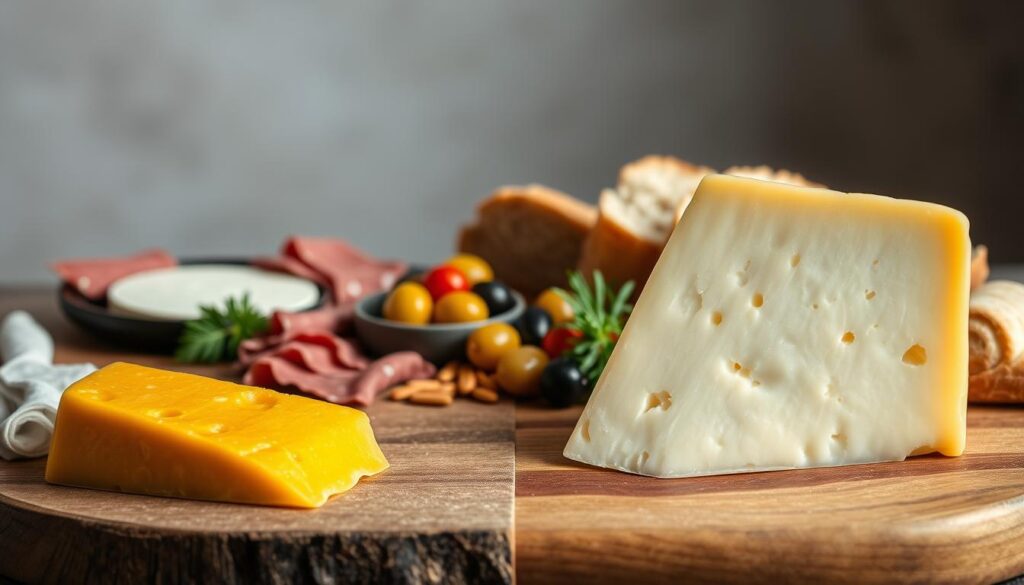
Knowing these differences helps us choose the right cheese for our dishes. Whether it’s Caciocavallo, Provolone, or other Italian Cheeses1213.
Culinary Applications and Serving Suggestions
Caciocavallo cheese is great for many Culinary Applications. It’s perfect for both traditional Italian dishes and new recipes. Its taste and texture are great with white wines for Wine Pairing. You can find endless Caciocavallo Recipes, from simple snacks to big meals14.
For a taste of Italy, try Caciocavallo with Murray’s Roasted & Salted Pistachios and Dehesa Cordobesa Paleta Iberico DeBellota15. It’s perfect for a cheese platter or a quick snack. You can also use it in Caciocavallo Recipes like panini, sandwiches, or as a topping for baked dishes. It grills and melts well14.
Here are some ideas for Culinary Applications of Caciocavallo:
- Grilled Caciocavallo with fresh vegetables and herbs
- Caciocavallo and prosciutto panini
- Baked pasta with Caciocavallo and tomato sauce
These dishes show how versatile Caciocavallo is in Culinary Applications. It’s also great for creative Wine Pairing combinations16.
Storing and Preserving Your Caciocavallo
To keep your Caciocavallo cheese fresh, it’s key to store it right. Storing Caciocavallo in the fridge, in a drawer or veg bin, stops it from drying out17. The fridge’s control over humidity and temperature keeps the cheese moist.
When it comes to Preserving Cheese, the type matters. Hard cheeses like Caciocavallo can last weeks if wrapped and chilled18. Soft cheeses need extra care to avoid spoilage.
Here are some tips for Cheese Care:
- Store cheese in a cool, dry spot, away from sunlight and heat.
- Wrap it with breathable stuff like cheese paper or parchment.
- Keep it away from foods with strong smells, as it picks up odors fast.
By following these tips, you can enjoy your Caciocavallo’s rich taste and texture longer17. Always check for spoilage before eating, and store it to keep its quality and freshness18.
Buying Guide: Selecting Quality Caciocavallo
When you’re looking to buy Caciocavallo, a good guide is key. There are many types of Caciocavallo, like fresh, semi-matured, and matured. The price changes a lot based on the cheese’s age, quality, and where it comes from.
For top-notch Caciocavallo, search for cheese that’s smooth and shiny. It should taste mild and a bit sweet. The color can be white to pale yellow, depending on the cheese’s age and type. Always check where the cheese comes from. Southern Italy is famous for its excellent Caciocavallo19.
Here are some important things to think about when buying Caciocavallo:
- Age: Fresh, semi-matured, or matured
- Quality: Look for a smooth texture and mild flavor
- Source: Traditional production regions in Southern Italy
- Price: Varies depending on age, quality, and source
By using this guide, you can pick a great Caciocavallo. It doesn’t matter if you love cheese or are just trying something new. Buying Caciocavallo can be a fun and rewarding experience.
Health Benefits and Nutritional Value
Caciocavallo cheese is packed with nutrients, offering many health benefits20. It’s lactose-free and full of vitamins and antioxidants. It also has a low ratio of unhealthy fats to healthy fats20. The Health-Promoting Index (HPI) for Caciocavallo cheese is calculated using a special formula20.
Studies show that eating cheese, like Caciocavallo, can help prevent obesity21. It’s also great for your teeth because it fights tooth decay21. Plus, low-sodium cheeses, including some Caciocavallo, can lower blood pressure21.
When adding Caciocavallo to your diet, know its nutritional facts. It costs between €26 to €45 per kilogram, depending on how long it’s aged22. It has almost no lactose, making it naturally lactose-free22.
Caciocavallo cheese is a tasty and healthy part of a balanced diet. It’s full of good stuff like vitamins, antioxidants, and has very little lactose. It’s a great pick for those wanting to eat more
Here are some key points to consider when evaluating the health benefits and nutritional value of Caciocavallo cheese:
- High in vitamin A and antioxidants
- Naturally lactose-free
- Low PUFA-n6/n3 ratio
- Rich in bioactive components
- Supports healthy blood pressure levels
Caciocavallo cheese is not just tasty; it’s also good for you. Its unique nutritional profile makes it a great choice for a healthier diet20. With its bioactive components and low lactose, it’s perfect for boosting your health and wellbeing21.
Conclusion: Embracing the Tradition of Caciocavallo
Caciocavallo cheese is a true symbol of Italian culinary tradition and regional pride. It comes from Italy’s southern regions23 and is made with great care. This cheese shows the lasting impact of Italian cheese culture.
Caciocavallo stands out with its unique taste and texture23. The cheese’s flavor comes from traditional farming methods23. Enjoying Caciocavallo lets us appreciate the variety and depth of Italian cheeses.
Admiring Caciocavallo is more than just tasting it. It’s about honoring Italy’s rich cultural heritage24. The cheese’s story is tied to Italy’s food markets and passionate producers24.
Exploring Caciocavallo and other Italian cheeses connects us to traditions and people25. Each bite is a journey to Italy’s sunny lands and its cheese-making history.
FAQ
What is Caciocavallo Cheese?
Caciocavallo is a special Italian cheese from Southern Italy. It’s a stretched-curd cheese that’s been loved in Italian food for ages.
What is the taste and texture of Caciocavallo Cheese?
Caciocavallo tastes nutty and slightly sweet. Its firm but soft texture makes it great for cooking.
How do you eat Caciocavallo Cheese?
You can enjoy Caciocavallo in many ways. Slice it for snacks, melt it in Italian recipes, or try it in new cooking styles.
How does Caciocavallo compare to Provolone Cheese?
Caciocavallo and Provolone are both Italian cheeses but different. Caciocavallo is seen as more unique and handmade compared to Provolone.
How do you melt Caciocavallo Cheese?
Its texture is perfect for melting. Slice, grate, or cube it to add to dishes, where it melts well with other ingredients.
What are some traditional Italian recipes that use Caciocavallo Cheese?
Caciocavallo is used in many Italian dishes. It’s great in pasta, pizzas, and sandwiches. It adds flavor and texture when melted, grilled, or in sauces.

